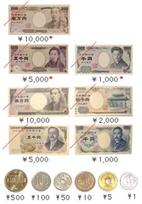Detailed chart analysis of past trading action
Identified where reversion and break-out trading occurred
The image below is the chart of Japanese Yen futures contract ( CME Ticker Symbol: 6J ).
It is a multi-days chart showing Composite Time Price Opportunity (TPO) Profile on the left side
and Composite Volume Profile on the right side.
This is an unique charting technique and requires some explanation on how to read the chart.
This chart shows more information than the conventional graphical chart. Don't be overwhelm.
Once you get accustomed to reading this type of chart, it will stimulate your whole brain. The
left hemisphere of your brain which is responsible for logical, rational and analytical functions will
be engaged by the numerical data portion of the chart. The right hemisphere of your brain which
is responsible for the intuitive and subjective functions will be engaged by the graphical portion of
the chart.
This gives you an advantage of engaging your whole mind when it comes to trading instead of using
just a section of it.
Showing
Time Price Opportunity (TPO)
Profile side-by-side to Volume Profile gives you a quick synopsis of
- which price levels received the most trading volume
- at what time during the trading session had it traded there
- how many times it had backfilled to those price levels
- where reversion trades worked for traders fading the move as price traded back and forth to form a cluster node
- see where and when break-out trades occurred as price spends very little time trading there
(Click on image below to bring up thumbnail and enlarge the chart.)

Legends:
- VAH = Value Area High
- VAL = Value Area Low
- POC = Point of Control (i.e. where most of the trading volume had occurred)
- TPO Count = Where trading has spent the most time
- VWAP = Volume-Weighted Average Price
- BOO = Break-out Octet. Minimum stop loss risk on false break-outs
- BDO = Break-down Octet. Minimum stop loss risk on false break-downs
- Spot = Spot FX price quotation on USD/JPY currency pair.
- Each TPO letter represents half hour intervals
- TPO { abcdefghijklmnop } are the Asian Session
- TPO { qrst } are when both Asian and European Traders are awake, alert and online
- TPO { uvwx } are the remaining European Session
- TPO { yzVWXYZABCDE } are when both European and American Traders are awake, alert and online
- TPO { FGHIJKLMNOPQ } are the remaining American Session
Country Profile and Fundamental Analysis
Japan is an archipelago of 6,852 islands. The four largest islands together account for 97% of Japan's
land area and they are Honshū, Hokkaidō, Kyūshū and Shikoku.
Tokyo is the capital of Japan and it is located on the eastern side of the main island of Honshū.
The city of Tokyo is one of the three world finance "command centers", along with New York City and London.
The national spoken language is Japanese (日本語) and the national written language
is kanji 日本.
Japan's main export markets are to China, the United States, South Korea, Taiwan and Hong Kong. Transportation
equipments, motor vehicles, electronics, electrical machineries and chemicals are Japan's main exports.

The international currency symbol is ¥. It is pronounced yen and the local Japanese yen word is 円.
The Bank of Japan is the central bank for the country. BOJ has adopted a Zero Interest Rate Policy as a way to
work itself out of a deflationary economic environment. Despite Westerns ridiculing the yen for its low interest rate
(i.e., why would someone own the yen that earns 0% interest rate), the yen has continued to appreciate in value.
Lost in the translation and disparagement of a zero interest rate economic policy, Westerners are missing the
salient point that Japan is fighting deflation. Deflation means that you can buy more stuff in the future with
the same amount of yen. This makes the yen an appreciating fiat money because it is a medium that can store wealth.
In contrast to other countries' fiat currencies, that have inflationary policies, money is a depreciating
asset.
In addition to trading the Japanese Yen in the forex market, any excess idle cash holdings of the Japanese
Yen can be put to use for trading Japanese stocks. The Tokyo Stock Exchange Trading Network (ToSTNeT) is open
from 8:20am to 5:30pm local time.

|
